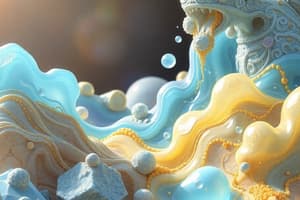Podcast
Questions and Answers
Why are ceramics considered brittle materials?
Why are ceramics considered brittle materials?
- Because they are always exposed to high temperatures
- Because they have low density
- As a result of their high electrical conductivity
- Due to the presence of porosity (correct)
What process is used to produce polymers?
What process is used to produce polymers?
- Polymerization (correct)
- Fermentation
- Distillation
- Oxidation
Why are polymers typically not suitable for high-temperature applications?
Why are polymers typically not suitable for high-temperature applications?
- Because they are too heavy
- Because they have low strength at high temperatures (correct)
- Because they lack resistance to corrosive chemicals
- Due to their poor electrical resistivity
What distinguishes thermoplastics from thermosetting polymers?
What distinguishes thermoplastics from thermosetting polymers?
What is a key characteristic of electronic materials like silicon and gallium arsenide-based semiconductors?
What is a key characteristic of electronic materials like silicon and gallium arsenide-based semiconductors?
What is a common application of plastics according to the text?
What is a common application of plastics according to the text?
Why are alkali and alkaline earth metals labeled as electropositive?
Why are alkali and alkaline earth metals labeled as electropositive?
Which group in the periodic table includes transition metals?
Which group in the periodic table includes transition metals?
What is a characteristic of elements in groups IIIA, IVA, and VA in terms of their valence electron structures?
What is a characteristic of elements in groups IIIA, IVA, and VA in terms of their valence electron structures?
What term is used to describe elements on the right side of the periodic table?
What term is used to describe elements on the right side of the periodic table?
According to Figure 2.9, how does electronegativity change when moving from left to right in the periodic table?
According to Figure 2.9, how does electronegativity change when moving from left to right in the periodic table?
In terms of electronegativity values, how does moving from bottom to top influence the elements in the periodic table?
In terms of electronegativity values, how does moving from bottom to top influence the elements in the periodic table?
What does resilience refer to in materials?
What does resilience refer to in materials?
How is engineering stress calculated?
How is engineering stress calculated?
What is true stress in materials based on?
What is true stress in materials based on?
What is the defining feature of unsaturated molecules?
What is the defining feature of unsaturated molecules?
How do the intramolecular bonds in organic materials typically form?
How do the intramolecular bonds in organic materials typically form?
What does true strain provide a more accurate measure of compared to engineering strain?
What does true strain provide a more accurate measure of compared to engineering strain?
What drives the hardening of inorganic cements like Portland cement?
What drives the hardening of inorganic cements like Portland cement?
What unique properties make oxide ceramics valuable?
What unique properties make oxide ceramics valuable?
What is the primary mechanism of diffusion in ionic materials?
What is the primary mechanism of diffusion in ionic materials?
Which technique is commonly used to measure the hardness of ceramic materials?
Which technique is commonly used to measure the hardness of ceramic materials?
Why are bioceramics commonly used in biomedical applications?
Why are bioceramics commonly used in biomedical applications?
What distinguishes diamond from graphite in terms of physical and chemical properties?
What distinguishes diamond from graphite in terms of physical and chemical properties?
What is the main difference between the Bohr atomic model and the wave-mechanical model?
What is the main difference between the Bohr atomic model and the wave-mechanical model?
How does Schrödinger's atomic model differ from the Bohr atomic model?
How does Schrödinger's atomic model differ from the Bohr atomic model?
What is the significance of the Pauli exclusion principle in quantum mechanics?
What is the significance of the Pauli exclusion principle in quantum mechanics?
Which subshell can hold a maximum of 10 electrons according to quantum mechanics?
Which subshell can hold a maximum of 10 electrons according to quantum mechanics?
What are valence electrons in an atom?
What are valence electrons in an atom?
In quantum mechanics, how is electron position described in Schrödinger's atomic model?
In quantum mechanics, how is electron position described in Schrödinger's atomic model?




